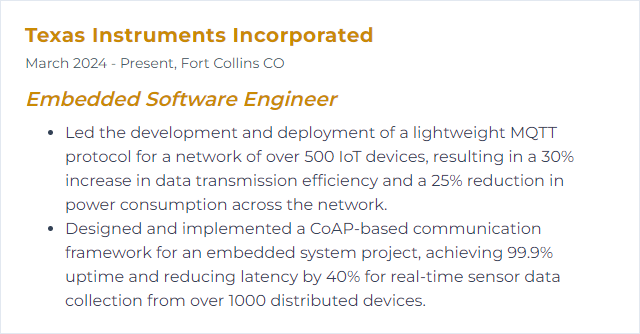Top 12 Embedded Software Engineer Skills to Put on Your Resume
In a field that never stops twitching forward, an embedded software engineer’s resume has to show range and real-world bite. The mix matters: tight control of the metal, clean software habits, and the kind of judgment that keeps products shipping and support calls quiet. Spotlight the skills that map to today’s stacks and tomorrow’s ramp-up, and you’ll look like someone people can trust in the lab and at launch.
Embedded Software Engineer Skills
- C/C++
- Python
- RTOS
- ARM Architecture
- Linux/Unix
- Microcontrollers
- FPGA
- Embedded Linux
- I2C/SPI
- Bluetooth Low Energy (BLE)
- Git
- IoT Protocols
1. C/C++
C and C++ anchor embedded development. You get direct hardware access, deterministic performance, and control over memory and timing when every byte and microamp matters.
Why It's Important
C/C++ deliver close-to-the-metal control and predictable performance, making them the backbone for firmware and real-time components in resource-constrained devices.
How to Improve C/C++ Skills
Level up by mixing fundamentals with hands-on builds and careful profiling.
Rebuild the core: Be fearless with pointers, memory layouts, const-correctness, volatile, and bitwise operations. Understand object lifetimes and value categories in modern C++.
Write, measure, repeat: Solve small problems daily, then move into projects that hit peripherals, timers, and interrupts. Benchmark before “optimizing.”
Know the platform: Read datasheets, linker scripts, startup code, and memory maps. Practice writing drivers against registers, not just HALs.
Modern C++ wisely: Adopt C++17/20 features that shrink bugs and boost clarity (RAII, span, constexpr, structured bindings) without inflating code size.
Debug like a pro: Use static analysis, sanitizers (where possible), disassembly views, and map files. Track stack and heap usage; watch for fragmentation.
Tighten the loops: Inline hot paths judiciously, avoid unnecessary heap work, prefer fixed-size buffers, and keep ISR work minimal.
Touch hardware: Bring up boards, poke GPIOs, read sensors, and tune timers. Real hardware teaches what no book can.
Read and review: Study high-quality codebases. Do code reviews with a focus on correctness and determinism.
Stay curious, keep shipping small artifacts, and let the profiler call the shots.
How to Display C/C++ Skills on Your Resume
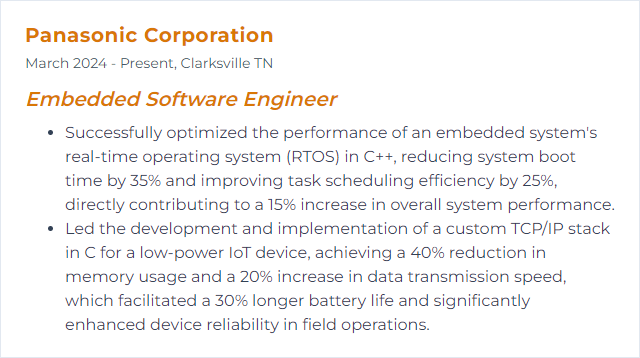
2. Python
Python speeds up glue work, scripting, test harnesses, data parsing, and tooling. On constrained targets, MicroPython and CircuitPython can handle simple logic at the edge.
Why It's Important
It slashes development time for automation, CI testing, log analysis, factory tools, and quick prototypes—freeing C/C++ for the tight loops.
How to Improve Python Skills
Back to basics: Master iteration, comprehensions, exceptions, packaging, and virtual environments. Write clean, typed code with type hints.
Think embedded: Explore MicroPython/CircuitPython, learn memory/performance trade-offs, and keep allocations predictable.
Power features: Get comfortable with generators, decorators, context managers, and asyncio when appropriate.
Write for speed: Profile before optimizing. Cache results, batch I/O, and offload to C when needed (ctypes/CFFI).
Ship tools: Build flashing scripts, diagnostics dashboards, and test runners. Automate the boring work.
Test everything: Use pytest, mocks, and fixtures; integrate into CI to catch regressions early.
Use Python where it shines—interfaces, tests, tools—and keep the firmware lean.
How to Display Python Skills on Your Resume
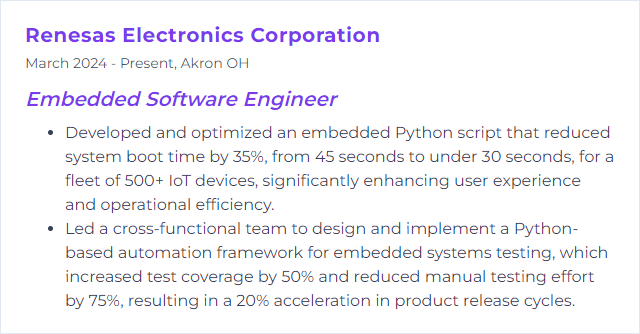
3. RTOS
A real-time operating system manages tasks, priorities, and timing so your device reacts predictably, every time, even under pressure.
Why It's Important
When timing isn’t a suggestion—motors, sensors, radios—an RTOS gives scheduling, synchronization, and determinism without reinventing the wheel.
How to Improve RTOS Skills
Choose the right policy: Use fixed-priority or deadline-based scheduling appropriate to your workload. Keep ISRs short; defer to tasks.
Tame latency and jitter: Prioritize interrupts carefully, bound critical sections, and avoid priority inversion with proper mutex protocols.
Memory discipline: Favor static allocations. If dynamic allocation is unavoidable, use pooled allocators to prevent fragmentation.
Clean IPC: Use queues, semaphores, and events deliberately. Document ownership and life cycles; avoid hidden coupling.
Power-aware design: Integrate sleep states with timers and wake sources. Budget CPU time and align wakeups.
Instrument everything: Trace scheduling, context switches, and ISR times. Use runtime stats to catch starvation and drift.
Harden the build: Enable stack overflow checks, watchdogs, and asserts. Test worst-case scenarios, not just happy paths.
Right-size the kernel: Configure features you actually need; shed the rest to cut latency and footprint.
Determinism comes from choices you can explain and numbers you can prove.
How to Display RTOS Skills on Your Resume

4. ARM Architecture
Arm cores power most embedded gear. RISC design, strong toolchains, and a sprawling ecosystem make it the default target from wrist sensors to gateways.
Why It's Important
It scales. Low power in tiny MCUs, multicore muscle in application processors, and consistent fundamentals across families keep engineering time focused on features, not porting purgatory.
How to Improve ARM Architecture Skills
Know the core: Learn the Cortex-M/A feature set, exception model, privilege levels, MPU, and cache behavior. Read the TRM.
Optimize with intent: Use compiler flags sensibly, align data, keep hot code in tight loops, and understand the generated assembly.
Exploit CMSIS and HALs: Start fast with standardized layers, but don’t be afraid to drop to registers for performance-critical paths.
Concurrency done right: Respect memory barriers and atomic operations. Get comfortable with interrupt priorities and tail-chaining.
Power first: Use sleep states, clock gating, and peripheral offloading. Measure current, don’t guess.
Debug deeply: JTAG/SWD, ETM/ETB tracing, ITM logging, and watchpoints. Correlate traces with events and timing.
Small architectural wins compound into big product gains.
How to Display ARM Architecture Skills on Your Resume
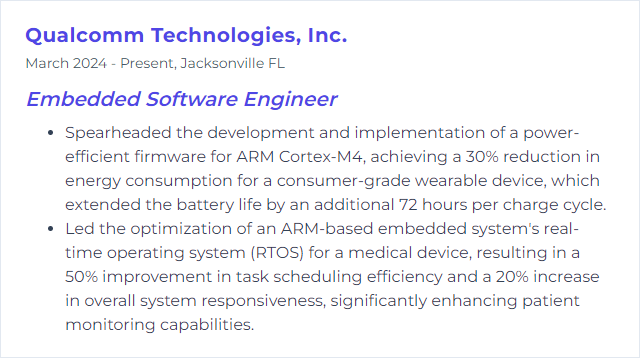
5. Linux/Unix
Linux is a Unix-like kernel and ecosystem; Unix is the older lineage that influenced it. Together they bring strong shells, drivers, networking, filesystems, and tooling to embedded work.
Why It's Important
Stable, flexible, and open. Perfect for gateways, smart devices, and anything that needs networking, drivers, security features, and a rich userland.
How to Improve Linux/Unix Skills
Scripting stamina: Write robust Bash scripts; orchestrate builds, tests, and deployments. Parameterize everything.
Systems programming: Work with syscalls, epoll, signals, and threads. Handle errors and timeouts meticulously.
Kernel fluency: Understand device trees, modules, and driver basics. Trim configs for faster boots and smaller images.
Real-time needs: Explore PREEMPT-RT and tick tuning. Measure latency, not just averages.
Build systems: Craft custom images with Buildroot or Yocto. Lock down reproducible builds and Software Bill of Materials.
Hardware I/O: Exercise GPIO, I2C, SPI, UART, and DMA from userland and kernel space. Monitor with logic analyzers.
Network chops: Socket programming, Netlink, firewall rules, secure services. Optimize throughput and latency.
Security posture: Embrace least privilege, MAC (SELinux/AppArmor), secure boot, signed packages, and patch hygiene.
Build minimal, measure often, and keep your images tame and traceable.
How to Display Linux/Unix Skills on Your Resume

6. Microcontrollers
MCUs bundle CPU, memory, and peripherals into a tiny, low-power package. Firmware on these chips steers sensors, motors, radios—everything close to the physical world.
Why It's Important
They’re the brains of countless devices. Understanding MCU constraints shapes products that last longer, boot faster, and behave reliably under stress.
How to Improve Microcontrollers Skills
Power discipline: Aggressive sleep modes, peripheral-triggered wakeups, and clock scaling. Measure currents across scenarios.
Code that fits: Fixed-capacity buffers, zero-cost abstractions, and O(1) operations in hot paths. Eliminate heap churn.
RTOS with care: Keep tasks purposeful, priorities tight, and shared resources guarded. Starvation and deadlocks are design smells.
Robust updates: Add secure boot, signed images, A/B slots, rollback protection, and atomic OTA. Fail safely.
Hardware abstraction: Clean HAL layers to isolate hardware changes and make unit testing possible.
Serious debugging: Use SWD/JTAG, ITM logging, logic analyzers, and oscilloscopes. Correlate firmware events with signals on the pins.
EMC awareness: Debounce inputs, filter noise, and design for ESD/EMI realities. Firmware can mitigate flaky hardware behavior.
Real skill shows up in stable field deployments, not demos on the bench.
How to Display Microcontrollers Skills on Your Resume

7. FPGA
FPGAs are reconfigurable logic devices. You mold hardware behavior with HDL to accelerate workloads and meet deadlines software alone can’t touch.
Why It's Important
When latency must fall or parallelism is king, FPGAs deliver customizable pipelines and deterministic timing without spinning a custom ASIC.
How to Improve FPGA Skills
Sharper HDL: Write synchronous, reset-sane code. Minimize logic depth on critical paths and keep combinational blobs under control.
Use resources wisely: Balance LUTs, BRAM, and DSP slices. Fit first, then speed up; pipeline where it pays.
Parallel on purpose: Unroll loops thoughtfully, partition data paths, and design for throughput rather than instruction speed.
Pipelining: Stage operations to raise Fmax. Accept a few cycles of latency to multiply throughput.
Clock and reset strategy: Clean clock-domain crossings, synchronizers, and constraints. No wishful thinking—prove CDC correctness.
Simulate and profile: Sim first, then synthesize. Use timing reports and on-chip analyzers to validate real behavior.
Power focus: Lower toggling, gate clocks, and prefer resource-light architectures when possible.
Great designs are boring in the lab: predictable, measurable, and stable.
How to Display FPGA Skills on Your Resume
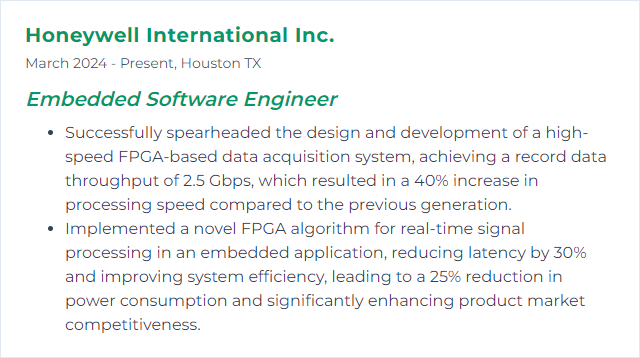
8. Embedded Linux
Embedded Linux means tailoring the kernel, drivers, and userland to fit tight hardware and specific product needs.
Why It's Important
You get flexibility, massive driver coverage, strong networking, and a big ecosystem—without starting from scratch.
How to Improve Embedded Linux Skills
Faster boots: Trim services, pare the device tree, tune kernel config, and defer nonessential init. Measure each cut.
Slim images: Build only what you need with Buildroot or Yocto. Strip symbols and prune dependencies.
Performance tuning: Profile with perf and ftrace. Consider PREEMPT-RT or isolcpus for realtime-ish behavior.
Security hardening: Enforce secure boot, signed packages, read-only rootfs where feasible, and MAC policies. Rotate keys and keep patches flowing.
Industrial-grade CI: Reproducible builds, image tests, hardware-in-the-loop, and artifact signing. Treat firmware like software releases.
Small, secure, observable systems behave better in the wild.
How to Display Embedded Linux Skills on Your Resume
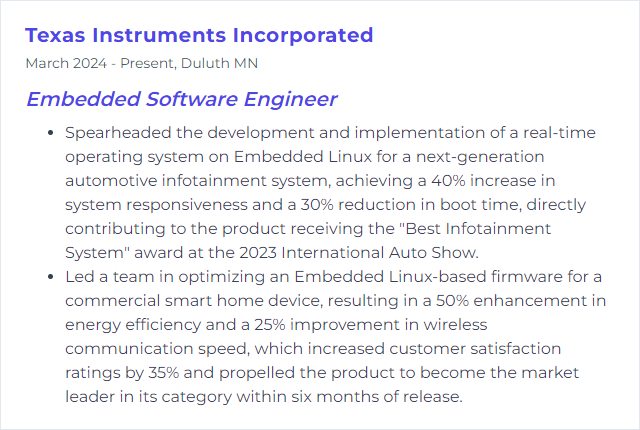
9. I2C/SPI
I2C and SPI are the workhorse serial buses for talking to sensors, memories, converters, and companion chips.
I2C: Two wires, addressing on-bus, multi-master capable, modest speed, simple routing.
SPI: Four wires (plus chip selects), higher speed, simple framing, one master by default.
Pick based on bandwidth, pin budget, and device mix.
Why It's Important
They connect almost everything inside a product. Robust bus work means fewer field issues and cleaner integrations.
How to Improve I2C/SPI Skills
I2C Improvement Strategies
Right pull-ups: Size pull-ups for the bus capacitance and speed; too strong wastes power, too weak smears edges.
Clock sanity: Choose standard, fast, or fast-plus mode deliberately. Validate rise/fall times with a scope.
Recover gracefully: Implement timeouts, bus-clear on stuck lines, and retries. Handle arbitration loss cleanly.
Address planning: Map devices to avoid conflicts; use multiplexers or GPIO-configurable addresses when needed.
SPI Improvement Strategies
Frequency fits: Match SCK to signal integrity and slave timing. Longer traces and flex cables want slower clocks.
Layout discipline: Tight routing, clean returns, controlled impedance if fast. Keep chip-selects glitch-free.
DMA where possible: Offload bulk transfers to DMA for steady throughput and lower CPU load.
Mode match: Align CPOL/CPHA, bit order, and word size to the datasheet. Don’t guess—verify on a logic analyzer.
Checks and buffers: Add CRCs when data integrity matters; double-buffer for streaming workloads.
Instrument the bus, watch the waveforms, and your drivers will behave.
How to Display I2C/SPI Skills on Your Resume
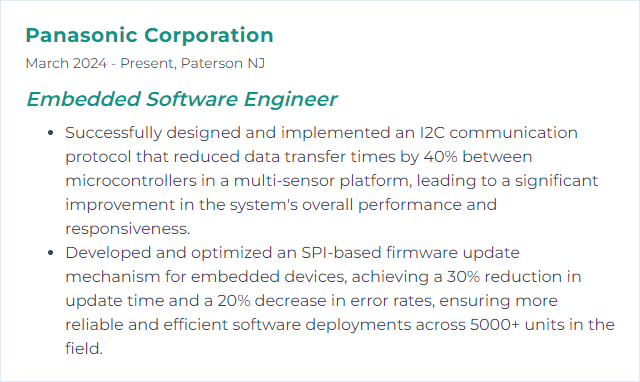
10. Bluetooth Low Energy (BLE)
BLE is a low-power wireless protocol for short-range links. Think sensors, wearables, tags, and controls that sip current and keep talking.
Why It's Important
It’s everywhere in IoT and mobile ecosystems. Low energy, wide device support, and a mature stack of profiles make integration practical.
How to Improve Bluetooth Low Energy (BLE) Skills
Power first: Tune connection intervals, slave latency, and supervision timeouts. Sleep deep and wake with purpose.
Throughput where needed: Use larger MTUs, data length extensions, and appropriate PHYs (1M, 2M, or coded) based on range and data needs.
Radio resilience: Embrace adaptive frequency hopping, handle interference, and implement robust reconnection logic.
State machines: Design clean GATT state handling for discovery, bonding, and updates. Avoid blocking callbacks.
Keep current: Update stacks and firmware regularly for security fixes, interoperability, and performance improvements.
Measure, don’t assume: Use protocol sniffers and power analyzers. Validate packet timing, retries, and current profiles.
Bleeding power quietly and failing silently is easy. Good telemetry prevents both.
How to Display Bluetooth Low Energy (BLE) Skills on Your Resume
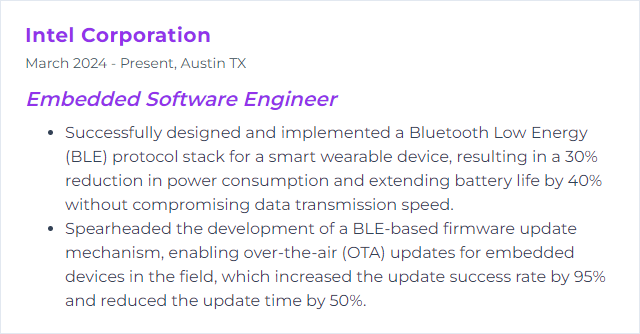
11. Git
Git tracks change history and lets teams branch, review, and merge with confidence. Firmware, drivers, docs—keep it all traceable.
Why It's Important
Complex embedded projects touch many repos and binaries. Git brings order, auditability, and collaboration to the chaos.
How to Improve Git Skills
Solid foundations: Clean commits, meaningful messages, and small diffs. Let history tell a story someone can follow.
Branching strategy: Pick trunk-based or a disciplined flow, then stick to it. Automate guardrails with checks.
Reviews that matter: Enforce code reviews, linters, and tests. Protect main with required checks.
Rebase with care: Keep feature branches tidy; avoid rewriting public history. Know when to merge.
Handle binaries: Use LFS or artifact storage for large images and logs. Don’t bloat the repo.
Submodules/subtrees: Use sparingly and document clearly. Consider vendoring for stability.
CI everywhere: Build, test, and package on each push. Tag releases, sign artifacts, and archive provenance.
Scaling tricks: Shallow clones, sparse checkouts, and partial clones keep big repos responsive.
Version control is a reliability practice, not just a tool preference.
How to Display Git Skills on Your Resume
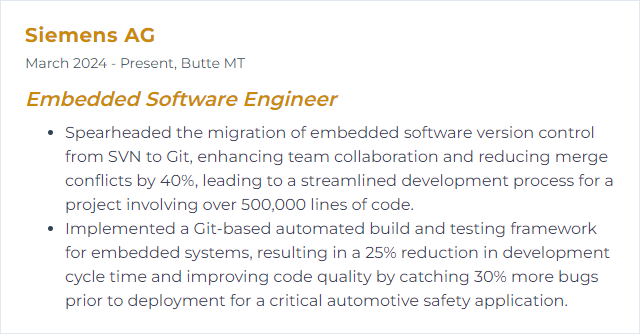
12. IoT Protocols
IoT protocols define how devices talk—efficiently, securely, and at scale—across lossy networks and tight budgets.
Why It's Important
Interoperability and reliability depend on the right protocol fit. Good choices reduce bandwidth, extend battery life, and simplify cloud integration.
How to Improve IoT Protocols Skills
Security by default: Encrypt transports, authenticate endpoints, rotate keys, and harden against replay and downgrade attacks.
Power-aware design: Batch messages, compress payloads, and align network wake windows with sleep schedules.
Choose lean: Prefer compact protocols like CoAP or MQTT-SN for constrained devices; keep payloads binary when possible.
Standards matter: Follow IETF and industry specs; stick to well-known profiles to avoid one-off glue everywhere.
Think scale: Use MQTT or AMQP for fan-in, apply backoff and QoS wisely, and plan for device fleets, not just dev kits.
IPv6 and friends: Leverage IPv6/6LoWPAN/Thread when addressing and mesh routing simplify your architecture.
OTA built-in: Signed updates, delta patches, staged rollouts, and safe rollback paths. Visibility into update success rates.
Test the edges: Validate under packet loss, jitter, clock drift, and flaky power. Fuzz parsers. Verify spec compliance.
Design for the messy network you’ll actually ship into, not the perfect one in your lab.
How to Display IoT Protocols Skills on Your Resume
